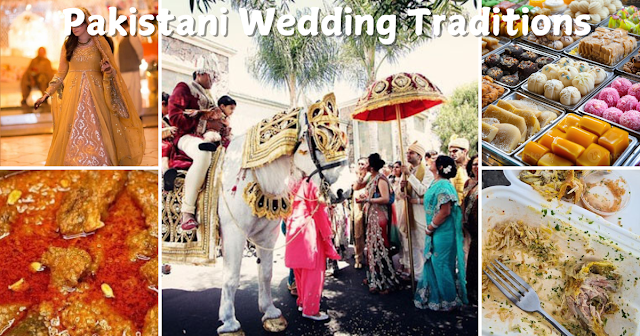Pakistani Wedding Traditions: A Kaleidoscope of Culture.
Pakistani Wedding Traditions.
Pakistani weddings aren’t just events—they’re full-blown festivals! If you’ve ever been invited to one, cancel all your other plans because this is going to be a days-long affair filled with laughter, dance, food, and countless traditions that reflect the country's rich cultural diversity. Ready to dive into the magic of Pakistani wedding traditions? Let’s break it down, one dazzling event at a time.
The Proposal and Engagement (Mangni)
Before the glittering chaos begins, it all starts with the formal proposal. Typically, the groom's family approaches the bride’s family with the marriage proposal. Once the families agree, the couple is officially engaged in a ceremony called Mangni. Rings are exchanged, and prayers are said for the couple's future happiness. The proposal can be simple or extravagant, but the joy shared by both families is always abundant.
(Urdu Translation: Mangni, rishta manzoor honay ke baad ki jati hai, jismein dono families khushi manati hain aur duaon ke saath ring ka tabadla hota hai.)
Mayoun: The Glow of Tradition
This pre-wedding ritual is all about prepping the bride for her big day. Think of it as a bridal glow-up! The bride is pampered with homemade beauty treatments, typically turmeric (ubtan) is applied to her skin by family members to give her that natural wedding glow. She's then restricted from leaving the house until the wedding to "protect" her from any bad omens. Yes, it’s a bit old-school, but it’s charmingly sacred.
(Urdu Translation: Mayoun mein dulhan ko ghar ki murtab ki gai ubtan lagayi jati hai aur usay ghar se bahar jane se mana kiya jata hai.)
Dholki: The Rhythm of Celebration
What’s a Pakistani wedding without music and dance? The Dholki is where the party truly starts. This event can stretch over several nights, with friends and family gathering to sing traditional wedding songs, beat the dhol (a type of drum), and dance their hearts out. It’s an informal, fun-filled occasion where the groom's and bride's families loosen up before the more formal events.
(Urdu Translation: Dholki shadi ki mehfil ka aghaz hai, jismein dhol bajaya jata hai aur sab mil kar gana gate hain.)
Mehndi: A Night of Color and Joy
The Mehndi ceremony is one of the most visually stunning parts of a Pakistani wedding. The bride’s hands and feet are adorned with intricate henna designs, while family members sing and dance. Both the bride and groom’s sides celebrate separately, but the vibes are equally festive. Guests wear vibrant, colorful outfits and there’s often a lot of playful competition between the two sides. It’s also common for the groom’s name to be hidden within the bride’s henna designs—can he find it?
(Urdu Translation: Mehndi ki raat dulhan ke haath paon mehndi se sajaaye jate hain, aur dono taraf ke ghar walay khushi ka izhar karte hain.)
Baraat: The Grand Entrance of the Groom
Ah, the Baraat! The groom makes a grand entrance, often on a decorated horse (or sometimes a fancy car). His family and friends accompany him in a festive procession to the wedding venue, dancing and singing all the way. The bride’s family greets them, sometimes with a bit of playful teasing, and the formal wedding ceremony—Nikah—takes place.
In the Nikah, the bride and groom officially say “Qubool Hai” (I accept) in front of witnesses, making the marriage legally and religiously binding. Afterward, it's all smiles, congratulations, and emotional moments, especially as the bride and groom exchange their first looks.
(Urdu Translation: Baraat ka matlab hai dulha ki shandar entry, jismein uska gharana nachta gata venue tak aata hai, aur phir Nikah ke saath shadi ka aaghaz hota hai.)
Walima: The Grand Reception
After all the chaos and celebration of the main wedding day, comes the Walima, the wedding reception hosted by the groom’s family. It's more of a formal affair, a time for the couple to meet and greet their extended families, friends, and community. The bride often wears more understated yet elegant attire, and the food—oh, the food!—it's an elaborate feast, a showcase of the couple's families’ generosity and hospitality.
(Urdu Translation: Walima dulha ka gharana karta hai, jismein nayi zindagi ka aghaz doston aur rishtedaron ke saath manaya jata hai.)
Rukhsati: The Emotional Farewell
Here comes the tearjerker—the Rukhsati. It marks the bride's departure from her parent's home, accompanied by emotional goodbyes. The bride's family sheds many tears as they send her off to start a new chapter with her husband. It's a bittersweet moment that is both heart-wrenching and heartwarming.
(Urdu Translation: Rukhsati ek jazbati lamha hota hai, jab dulhan apnay waliden ko khuda hafiz keh kar apne nayi ghar jaati hai.)
Pakistani Weddings: More Than Just a Celebration
Pakistani weddings are a melting pot of cultural traditions and family values. From the colorful Mehndi to the emotional Rukhsati, these traditions are more than just rituals—they symbolize the union of two families, the start of a lifelong partnership, and the celebration of love.
And the best part? The memories made during these few days last a lifetime.
(Urdu Translation: Pakistani shadiyaan sirf rasmain nahi hoti, yeh do khandanoun ki mile julne aur mohabbat ke safar ki ibtida hoti hain.)
So, if you ever get an invitation to a Pakistani wedding, prepare yourself for a cultural extravaganza—and don't forget to wear your dancing shoes!


.png)
.png)

.jpg)
Post a Comment